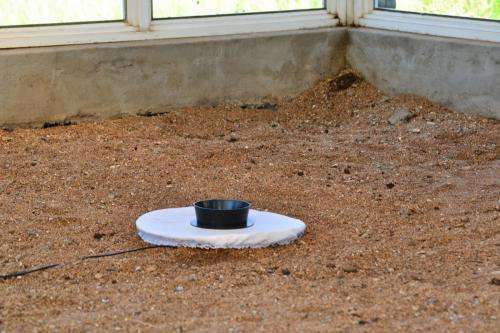'Attract and kill:' Trapping malaria mosquito mums before they lay eggs

In a world first, researchers have found that a naturally occurring chemical attracts pregnant malaria-transmitting mosquitoes - a discovery which could boost malaria control efforts.
The chemical, cedrol, found in mosquito breeding sites near Africa's Lake Victoria, could be used in traps that would 'attract and kill' the female mosquito, preventing reproduction before she lays hundreds of eggs.
A child dies every minute from malaria, according to World Health Organization estimates. In Africa, malaria parasites carried by the female Anopheles gambiae mosquito are responsible for most of those deaths. While current methods have reduced the burden of malaria, new control tools are desperately needed as mosquitoes develop resistance to insecticides and avoid indoor controls such as bed nets.
While much research has been done into repellents and attractants of malaria-transmitting mosquitoes as they hunt humans for a blood meal, this is the first chemical confirmed to attract female mosquitoes after they have fed, while they search for a place to lay their eggs, and offers a new way to control mosquitoes.
The work was published in the Malaria Journal by the OviART research group, a multinational team bringing together researchers from the Kenya-based International Centre of Insect Physiology and Ecology (icipe), the London School of Hygiene & Tropical Medicine, the Swedish Royal Institute of Technology and the UK's Durham University.
Vector control - preventing contact between mosquitoes and people and reducing the number of mosquitoes - is considered to be the best strategy to tackle malaria in sub-Saharan Africa.
Many studies have asked how the blood-thirsty mosquito finds human targets for a blood meal, and many successful control methods focus on protecting people from bites. Several chemicals have been identified that attract hungry mosquitoes looking for a feed, and odour-based traps have been designed to attract the mosquito away before biting.
The OviART team asked: what happens next? How does the mosquito find suitable water bodies for her aquatic offspring after she has fed? And can we manipulate that choice?
"To improve vector control and work towards malaria elimination, we need to look beyond blood-feeding to better understand mosquito behaviour at other times in her life," said Mike Okal, an icipe researcher, a PhD student at the London School of Hygiene & Tropical Medicine, and corresponding author on the study.
The OviART project followed the Anopheles gambiae mosquito's journey: after a blood meal from a human, the female mosquito heads off to lays her eggs in a pool of still water. The team noticed that some pools would be full of larvae, while others remained empty.
"For the past six years, we have been studying how the major malaria-transmitting mosquito in Africa selects which pool to lay her eggs in, and asking how that choice could be manipulated so we can intercept and kill her before she lays hundreds of eggs," said Mr Okal.
The team in Kenya, at icipe's Thomas Odhiambo Research Station in Mbita on the shore of Lake Victoria, set up a number of pools of water with different infusions, such as grasses, different soils, even rabbit food pellets, and judged which pools the mosquitoes preferred to lay in by counting the number of mosquito larvae in each.
They quickly honed in on one particular soil, which they dubbed their 'magical mud'.
"We found the mosquitoes were more than twice as likely to lay eggs in water infused with this particular soil than in water fresh from Lake Victoria," said Mr Okal.
After various studies to confirm that it was an odour released from the soil infusion, rather than the look of the turbid water, that was attracting mosquitoes, the challenge was to isolate the precise chemical that drew them in.
Colleagues at the Swedish Royal Institute of Technology used gas chromatography coupled to mass spectrometry to identify a number of chemicals released from the soil-infused water and compared these with over 100 samples taken from natural mosquito breeding sites around Lake Victoria.
They quickly honed in on one - the sesquiterpene alcohol cedrol - which was present in their soil infusion and was also found in more than 50% of their natural habitat samples.
Back in Kenya, cedrol was tested at icipe on mosquitoes in cages and in the wild. Pregnant mosquitoes were offered a choice: lake water, or lake water treated with cedrol.
The team confirmed that the mosquitoes were two times more likely to lay eggs in water with cedrol in the laboratory and a controlled field environment. During their field test, the team showed that wild mosquitoes were three times more likely to be caught in traps baited with cedrol than in traps with lake water alone.
Project leader Dr Ulrike Fillinger, of icipe and the London School of Hygiene & Tropical Medicine, said the search for a chemical which attracts egg-bearing mosquitoes has a long history.
"Many supposed attractants have been suggested in previous publications, but these were based on small scale laboratory studies which showed that the mosquitoes can sense these chemicals, and didn't show whether they affect mosquito behaviour," said Dr Fillinger.
"Our study for the first time has carefully demonstrated that egg-bearing Anopheles gambiae mosquitoes can detect the chemical cedrol and are drawn to it in real-world circumstances."
"The next step for us is to show how we can use cedrol in traps as part of an 'attract and kill' strategy to complement current vector control methods and to protect people from the deadly malaria parasite carried by these mosquitoes."
More information: Jenny M. Lindh, Michael N. Okal, Manuela Herrera-Varela, Anna-Karin Borg-Karlson, Baldwyn Torto, Steven W. Lindsay, Ulrike Fillinger. Discovery of an oviposition attractant for gravid malaria vectors of the Anopheles gambiae species complex. Malaria Journal. DOI: 10.1186/s12936-015-0636-0
Journal information: Malaria Journal
Provided by London School of Hygiene & Tropical Medicine

















